2003 PONTIAC GRAND PRIX traction control
[x] Cancel search: traction controlPage 192 of 378
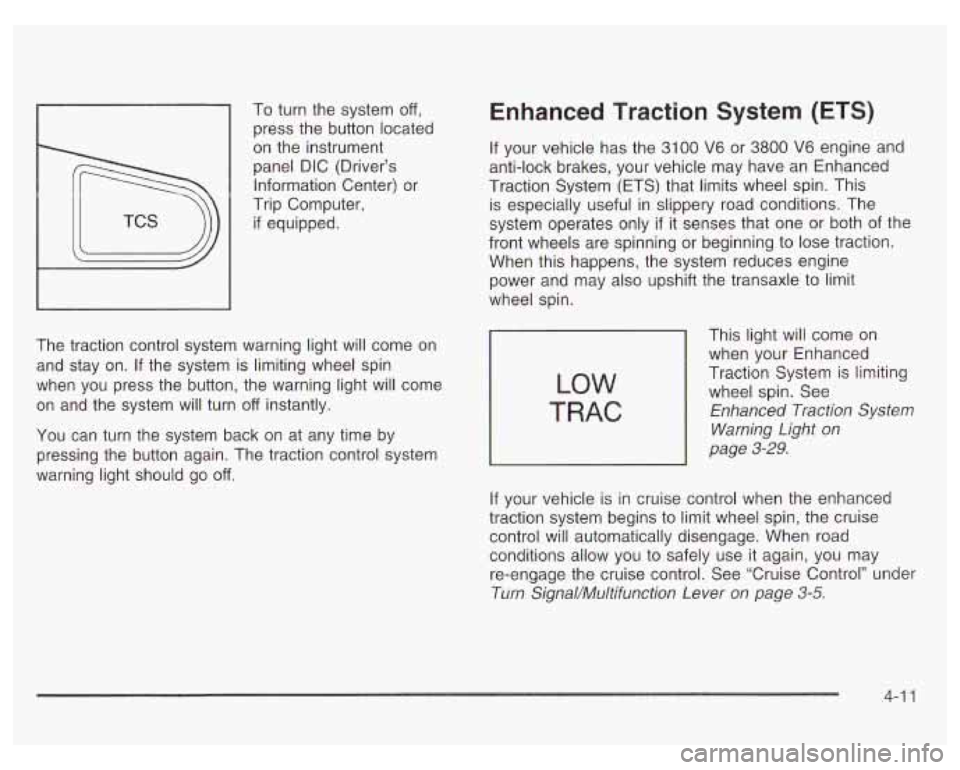
1 press the button located
To
turn the system
off,
on the instrument
panel DIC (Driver’s
Information Center) or
Trip Computer,
if equipped.
The traction control system warning light will come on
and stay on. If the system is limiting wheel spin
when you press the button, the warning light will come
on and the system will turn
off instantly.
You can turn the system back on at any time by
pressing the button again. The traction control system
warning light should go
off.
Enhanced Traction System (ETS)
If your vehicle has the 3100 V6 or 3800 V6 engine and
anti-lock brakes, your vehicle may have an Enhanced
Traction System (ETS) that limits wheel spin. This
is especially useful in slippery road conditions. The
system operates only
if it senses that one or both of the
front wheels are spinning or beginning to lose traction.
When this happens, the system reduces engine
power and may also upshift the transaxle to limit
wheel spin.
LOW
TRAC
This light will come on
when your Enhanced
Traction System is limiting
wheel spin. See
Enhanced Traction System
Warning Light
on
page 3-29.
If your vehicle is in cruise control when the enhanced
traction system begins to limit wheel spin, the cruise
control will automatically disengage. When road conditions allow you to safely use
it again, you may
re-engage the cruise control. See ‘Cruise Control’’ under
Turn Signal/Multifunction Lever
on page 3-5.
4-1 1
Page 194 of 378
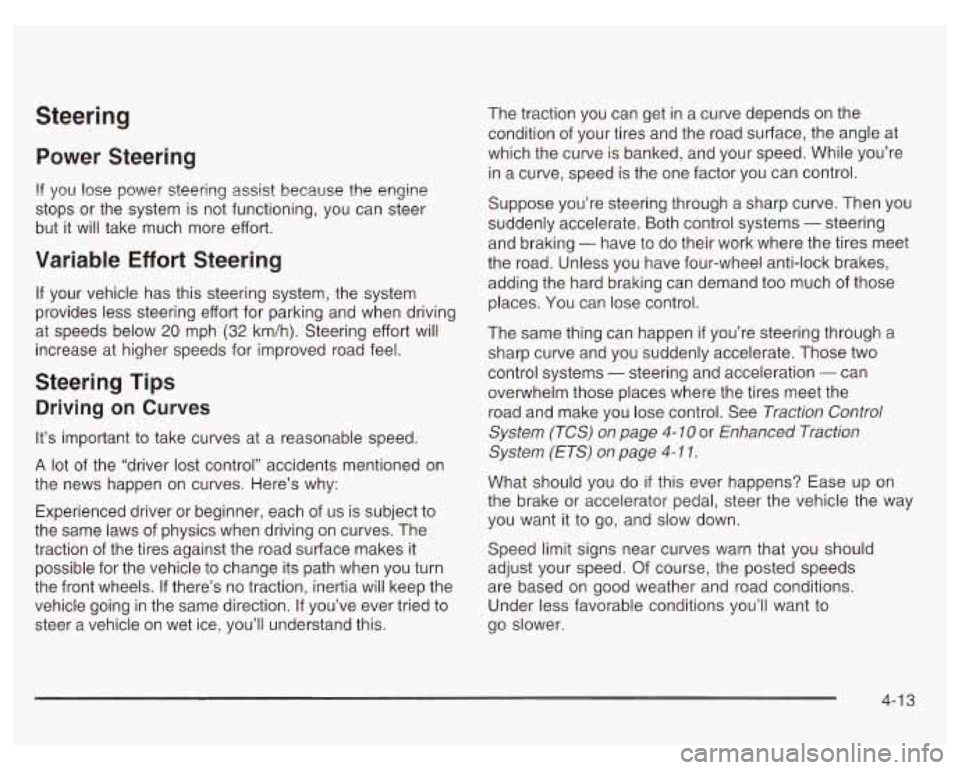
Power Steering
If you lose power steering assist because the engine
stops or the system is not functioning, you can steer
but it will take much more effort.
Variable Effort Steering
If your vehicle has this steering system, the system
provides less steering effort for parking and when driving
at speeds below
20 mph (32 km/h). Steering effort will
increase at higher speeds for improved road feel.
Steering Tips
Driving on Curves
It’s important to take curves at a reasonable speed.
A lot of the “driver lost control” accidents mentioned on
the news happen on curves. Here’s why:
Experienced driver or beginner, each of us is subject to
the same laws of physics when driving on curves. The
traction of the tires against the road surface makes it
possible for the vehicle to change its path when you turn
the front wheels. If there’s no traction, inertia will keep the
vehicle going in the same direction. If you’ve ever tried to
steer a vehicle on wet ice, you’ll understand this. The
traction you can get in a curve depends on the
condition of your tires and the road surface, the angle at
which the curve is banked, and your speed. While you’re
in a curve, speed is the one factor you can control.
Suppose you’re steering through a sharp curve. Then you
suddenly accelerate. Both control systems
- steering
and braking
- have to do their work where the tires meet
the road. Unless you have four-wheel anti-lock brakes,
adding the hard braking can demand
too much of those
places. You can lose control.
The same thing can happen
if you’re steering through a
sharp curve and you suddenly accelerate. Those two
control systems
- steering and acceleration - can
overwhelm those places where the tires meet the
road and make you lose control. See Traction Control
System (TCS) on page
4- 10 or Enhanced Traction
System (ETS)
on page 4- I 1.
What should you do if this ever happens? Ease up on
the brake or accelerator pedal, steer the vehicle the way
you want it
to go, and slow down.
Speed limit signs near curves warn that you should
adjust your speed. Of course, the posted speeds
are based
on good weather and road conditions.
Under less favorable conditions you’ll want to
go slower.
4-1 3
Page 198 of 378
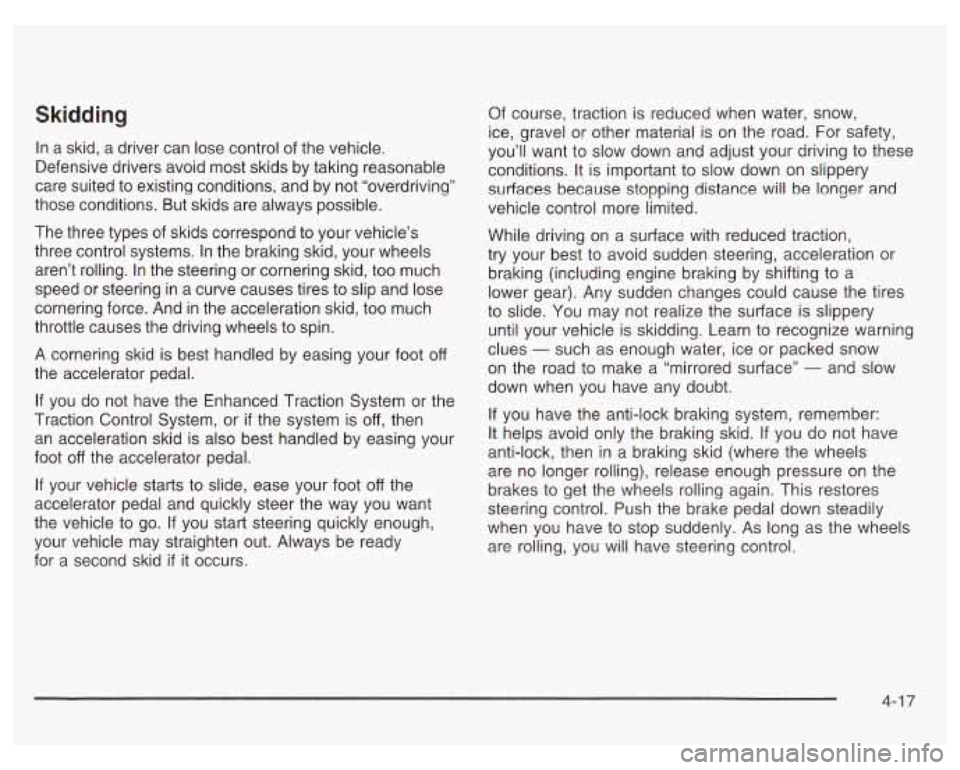
Skidding
In a skid, a driver can lose control of the vehicle.
Defensive drivers avoid most skids by taking reasonable
care suited to existing conditions, and by not “overdriving”
those conditions. But skids are always possible.
The three types of skids correspond to your vehicle’s
three control systems. In the braking skid, your wheels
aren’t rolling. In the steering or cornering skid, too much
speed or steering in a curve causes tires to slip and lose
cornering force. And
in the acceleration skid, too much
throttle causes the driving wheels to spin.
A cornering skid is best handled by easing your foot
off
the accelerator pedal.
If you do not have the Enhanced Traction System or the
Traction Control System, or
if the system is off, then
an acceleration skid is also best handled by easing your
foot
off the accelerator pedal.
If your vehicle starts to slide, ease your foot off the
accelerator pedal and quickly steer the way you want
the vehicle to go.
If you start steering quickly enough,
your vehicle may straighten out. Always be ready
for a second skid
if it occurs. Of
course, traction is reduced when water, snow,
ice, gravel or other material is on the road. For safety,
you’ll want to slow down and adjust your driving to these
conditions. It is important to slow down on slippery
surfaces because stopping distance will be longer and
vehicle control more limited.
While driving on
a surface with reduced traction,
try your best to avoid sudden steering, acceleration or
braking (including engine braking by shifting to a
lower gear). Any sudden changes could cause the tires
to slide. You may not realize the surface is slippery
until your vehicle is skidding. Learn to recognize warning
clues
- such as enough water, ice or packed snow
on the road to make a “mirrored surface”
- and slow
down when you have any doubt.
If you have the anti-lock braking system, remember:
It helps avoid only the braking skid.
If you do not have
anti-lock, then in a braking skid (where the wheels
are no longer rolling), release enough pressure on the
brakes to get the wheels rolling again. This restores
steering control. Push the brake pedal down steadily
when you have to stop suddenly. As long as the wheels
are rolling, you will have steering control.
4-1 7
Page 209 of 378
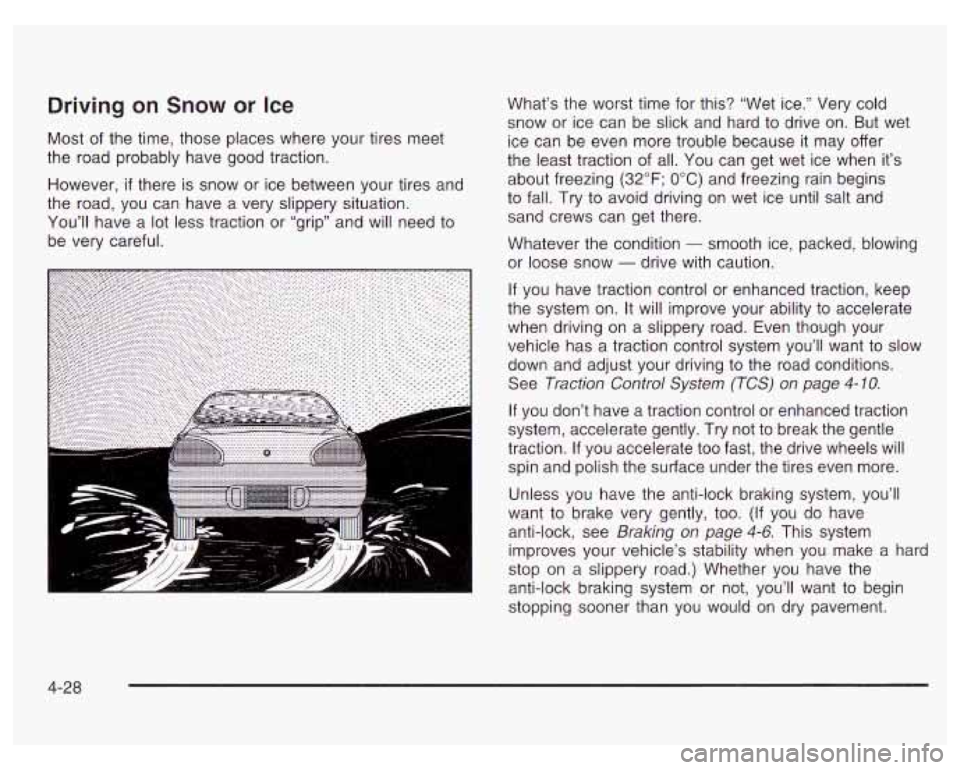
Driving on Snow or Ice
Most of the time, those places where your tires meet
the road probably have good traction.
However,
if there is snow or ice between your tires and
the road, you can have a very slippery situation.
You’ll have a lot less traction or “grip” and will need to
be very careful.
I I
What’s the worst time for this? “Wet ice.” Very cold
snow or ice can be slick and hard to drive on. But wet
ice can be even more trouble because it may offer
the least traction of all. You can get wet ice when it’s
about freezing
(32°F; OOC) and freezing rain begins
to fall. Try to avoid driving on wet ice until salt and
sand crews can get there.
Whatever the condition
- smooth ice, packed, blowing
or loose snow
- drive with caution.
If you have traction control or enhanced traction, keep
the system on. It will improve your ability to accelerate
when driving
on a slippery road. Even though your
vehicle has a traction control system you’ll want to slow
down and adjust your driving to the road conditions.
See Traction Control System (TCS) on page
4- 10.
If you don’t have a traction control or enhanced traction
system, accelerate gently. Try not to break the gentle
traction. If you accelerate too fast, the drive wheels will
spin and polish the surface under the tires even more.
Unless you have the anti-lock braking system, you’ll
want to brake very gently, too.
(If you do have
anti-lock, see Braking on
page 4-6. This system
improves your vehicle’s stability when you make a hard
stop on a slippery road.) Whether you have the
anti-lock braking system or not, you’ll want to begin
stopping sooner than you would on dry pavement.
4-28
Page 213 of 378

If You Are Stuck: In Sand, Mud,
Ice or Snow
In order to free your vehicle when it is stuck, you will
need
to spin the wheels, but you don’t want to spin your
wheels too fast. The method known as “rocking” can
help you get out when you’re stuck, but you must
use caution.
If yo
et your tires s 1 ai -. spee--7 ~~~ -y can
explode, and you or others could be injured.
And, the transaxle or other parts of the vehicle
can overheat. That could cause an engine
compartment fire or other damage. When you’re
stuck, spin the wheels as little as possible. Don’t spin the wheels above
35 mph (55 km/h)
as shown on the speedometer.
Notice: Spinning your wheels can destroy parts of
your vehicle as well as the
tires. If you spin the
wheels too fast while shifting your transaxle back
and forth, you can destroy your transaxle. See
“Rocking Your Vehicle To Get
It Out.’’
For information about using tire chains on your vehicle,
see Tire Chains on page
5-75.
Rocking Your Vehicle To Get It Out
First, turn your steering wheel left and right. That will
clear the area around your front wheels.
If your vehicle
has traction control, you should turn the system
off.
See Traction Control System (TCS) on page 4-10. Then
shift back and forth between REVERSE (R) and a
forward gear, spinning the wheels as little as possible.
Release the accelerator pedal while you shift, and press
lightly on the accelerator pedal when the transaxl is in
gear. By slowly spinning your wheels in the forward and
reverse directions, you will cause a rocking motion
that may free your vehicle. If that doesn’t get you out
after
a few tries, you may need to be towed out. If you
do need
to be towed out, see “Towing Your Vehicle”
following.
4-32
Page 297 of 378
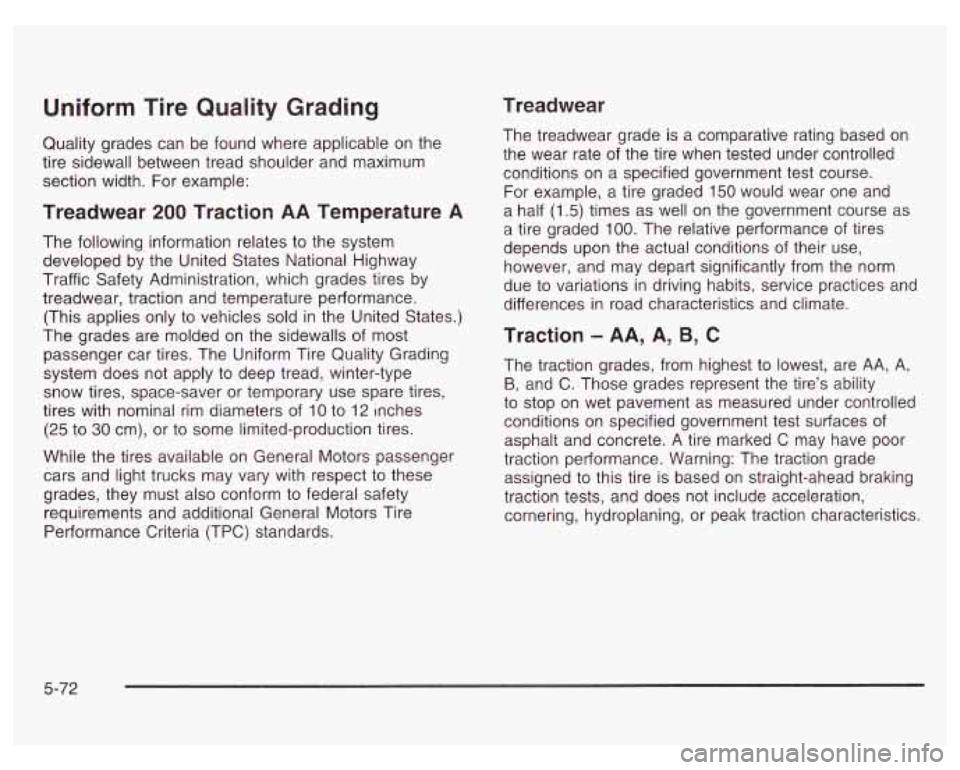
Uniform Tire Quality Grading
Quality grades can be found where applicable on the
tire sidewall between tread shoulder and maximum
section width. For example:
Treadwear 200 Traction AA Temperature A
The following information relates to the system
developed by the United States National Highway
Traffic Safety Administration, which grades tires by
treadwear, traction and temperature performance.
(This applies only to vehicles sold in the United States.)
The grades are molded on the sidewalls of most
passenger car tires. The Uniform Tire Quality Grading
system does not apply to deep tread, winter-type
snow tires, space-saver or temporary use spare tires,
tires with nominal rim diameters of
10 to 12 inches
(25 to
30 cm), or to some limited-production tires.
While the tires available on General Motors passenger
cars and light trucks may vary with respect to these
grades, they must also conform to federal safety
requirements and additional General Motors Tire
Performance Criteria (TPC) standards.
Treadwear
The treadwear grade is a comparative rating based on
the wear rate of the tire when tested under controlled
conditions on a specified government test course.
For example, a tire graded
150 would wear one and
a half
(1.5) times as well on the government course as
a tire graded
100. The relative performance of tires
depends upon the actual conditions of their use,
however, and may depart significantly from the norm
due to variations in driving habits, service practices and
differences in road characteristics and climate.
Traction - AA, A, 9, C
The traction grades, from highest to lowest, are AA, A,
B, and C. Those grades represent the tire’s ability
to stop on wet pavement as measured under controlled
conditions on specified government test surfaces
of
asphalt and concrete. A tire marked C may have poor
traction performance. Warning: The traction grade
assigned to this tire is based on straight-ahead braking
traction tests, and does not include acceleration,
cornering, hydroplaning, or peak traction characteristics.
5-72
Page 300 of 378
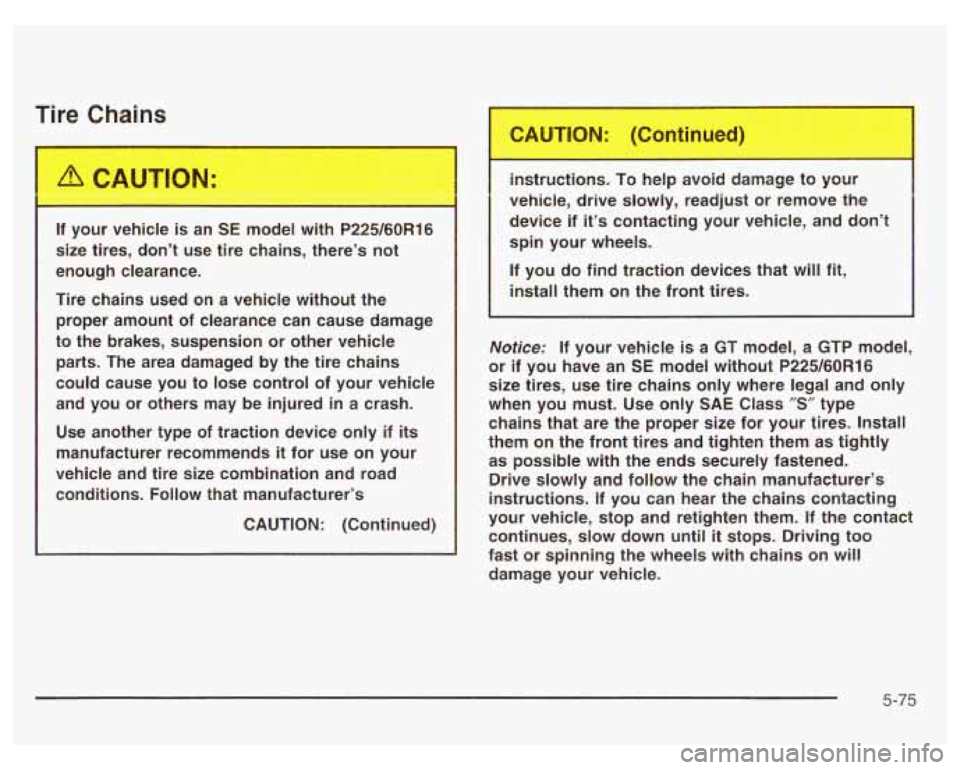
Tire Chains
If your vehicle is an SE model with P225/60R16
size tires, don’t use tire chains, there’s not
enough clearance.
Tire chains used on a vehicle without the proper amount of clearance can cause damage
to the brakes, suspension or other vehicle
parts. The area damaged by the tire chains
could cause you to lose control of your vehicle
and you or others may be injured in a crash.
Use another type of traction device only if
its
manufacturer recommends it for use on your
vehicle and tire size combination and road
conditions.
Follow that manufacturer’s
CAUTION: (Continued) instructions. To help avoid damage to your
vehicle, drive slowly, readjust or remove the
device if
it’s contacting your vehicle, and don’t
spin your wheels.
If you do find traction devices that will fit,
install them on the front tires.
Notice; If your vehicle is a GT model, a GTP model,
or if you have an
SE model without P225/60R16
size tires, use tire chains only where legal and only
when you must. Use only SAE Class
”S” type
chains that are the proper size for your tires. Install
them on the front tires and tighten them as tightly as possible with the ends securely fastened.
Drive slowly and follow the chain manufacturer’s
instructions. If you can hear the chains contacting
your vehicle, stop and retighten them.
If the contact
continues, slow down
until it stops. Driving too
fast or spinning the wheels with chains on will
damage your vehicle.
5-75
Page 367 of 378
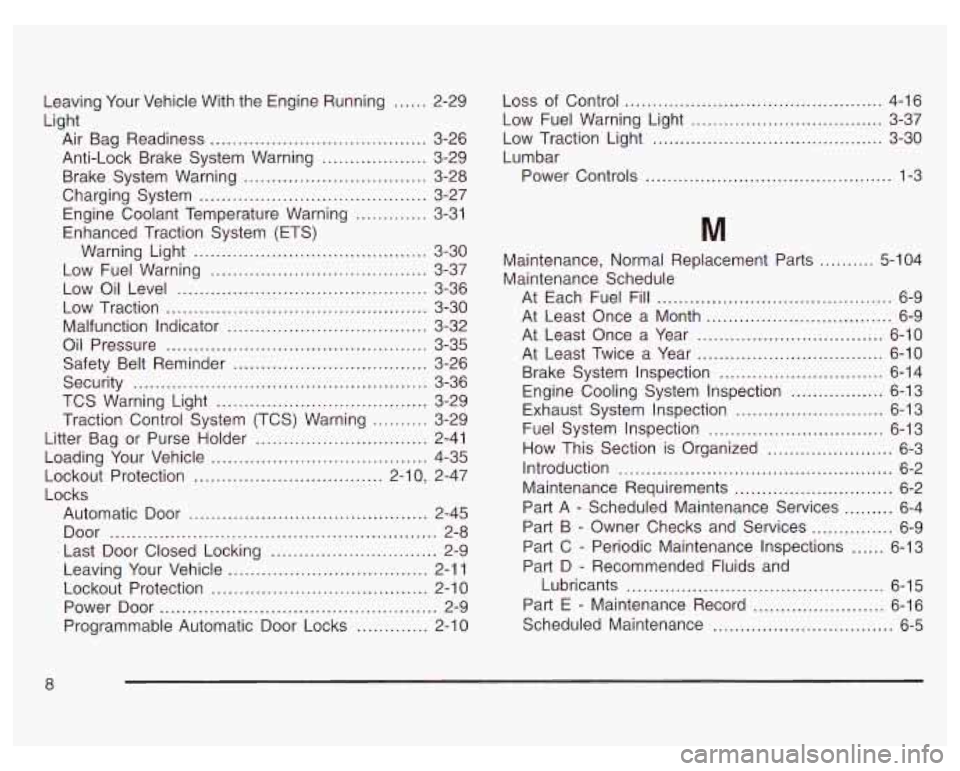
Leaving Your Vehicle With the Engine Running ...... 2-29
Air Bag Readiness
....................................... 3-26
Anti-Lock Brake System Warning
................... 3-29
Brake System Warning
................................. 3-28
Engine Coolant Temperature Warning
............. 3-31
Warning Light
.......................................... 3-30
Low Fuel Warning
....................................... 3-37
Light
Charging System
......................................... 3-27
Enhanced Traction System (ETS)
Low Oil Level
............................................. 3-36
Low Traction
............................................... 3-30
Malfunction Indicator
.................................... 3-32
Oil Pressure
............................................... 3-35
Safety Belt Reminder
................................... 3-26
Security
..................................................... 3-36
TCS Warning Light
...................................... 3-29
Traction Control System (TCS) Warning
.......... 3-29
Loading Your Vehicle
....................................... 4-35
Litter
Bag or Purse Holder
............................... 2-41
Lockout Protection
.................................. 2-10, 2-47
Locks
Automatic Door
........................................... 2-45
Door
........................................................... 2-8
Last Door Closed Locking
.............................. 2-9
Lockout Protection
....................................... 2-1 0
Power Door .................................................. 2-9
Programmable Automatic Door Locks
............. 2-1 0
Leaving Your Vehicle .................................... 2-1 1 Loss
of Control
.............................................. 4-16
Low Fuel Warning Light
................................... 3-37
Low Traction Light
...................................... 3-30
Lumbar Power Controls
........... ........... ... 1-3
M
Maintenance. Normal Replacement Parts .......... 5-1 04
Maintenance Schedule At Each Fuel Fill
........................................... 6-9
At Least Once a Month
.................................. 6-9
At Least Once a Year
.................................. 6-10
At Least Twice a Year
.................................. 6-10
Brake System Inspection
.............................. 6-14
Engine Cooling System Inspection
................. 6-13
Exhaust System Inspection
........................... 6-13
How This Section is Organized ....................... 6-3
Introduction
.................................................. 6-2
Maintenance Requirements
............................. 6-2
Part A
- Scheduled Maintenance Services ......... 6-4
Part B
- Owner Checks and Services ............... 6-9
Part C
- Periodic Maintenance Inspections ...... 6-13
Part D
- Recommended Fluids and
Lubricants
............................................... 6-15
Part E
- Maintenance Record ........................ 6-16
Scheduled Maintenance
................................. 6-5
Fuel
System Inspection
................................ 6-13
a